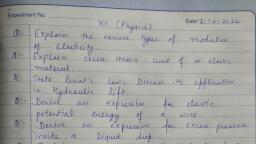Question 1 :
Two wires are made of the same material and have the same volume. However wire 1 has cross-sectional area $A$ and wire 2 has cross- sectional area $3A$. If the length of wire 1 increases by $\Delta \mathrm{x}$ on applying force $\mathrm{F}$, how much force is needed to stretch wire 2 by the same amount ?<br>
Question 2 :
The bulk modulus of a metal is $\displaystyle { 10 }^{ 10 }{ N }/{ { m }^{ 2 } }$ and Poisson's ratio $0.20$. If average distance between the molecules is $\displaystyle 3\overset { \circ  }{ A } $ then the inter atomic force constant :
Question 3 :
In a Young's double slit experiment with sodium light, slits are 0.589 m apart. The angular separation of the maximum from the central maximum will be (given $\lambda =589$nm,):
Question 4 :
A tension of $20\  N$ is applied to a copper wire of cross sectional area $0.01 cm^2$, Young's Modulus of copper is $1.1\times 10^{11} N/m^2$ and Poisson's ratio is 0.32. The decrease in cross sectional area of the wire is:
Question 5 :
A solid sphere of radius $R$ and density $\rho $ is attached to one end of a mass-less spring of force constant $k$. The other end of the spring is connected to another solid sphere of radius $R$ and density $3\rho $. The complete arrangement is placed in a liquid of density $2\rho $ and is allowed to reach equilibrium. The correct statement(s) is (are)<br>
Question 6 :
A body takes $10$ minutes to cool from ${ 60 }^{ o }C$ to ${ 50 }^{ o }C$. The temperature of surroundings is constant at ${ 25 }^{ o }C$. Then, the temperature of the body after next $10$ minutes will be approximately
Question 7 :
One likes to sit under sunshine in the winter season, because
Question 8 :
A black body is at temperature of $2800\ K$. The energy of radiation emitted by this object with wavelength between $499\ nm$ and $500\ nm$ is ${U}_{1}$, between $999\ nm$ and $1000\ nm$ is ${U}_{2}$ and between $1499\ nm$ and $1500\ nm$ is ${U}_{3}$. The Wient's constant, $b = 2.88 \times {10}^{6}\ nm-K$. Then,
Question 9 :
A body in a laboratory takes 4 minutes to cool from $61^oC $ and $59^oC$. If the laboratory temperature is $30^oC$ then the time taken by it to cool from $51^oC$ to $49^oC$ will be:<br/>
Question 10 :
A wire of length $1.0$ m and radius $10^{-3}$ m is carrying a heavy current and is assumed to radiate as a black body. At equilibrium its temperature is $900K$ while that of the surrounding is $300K$. The resistivity of the material of wire at $300K$ is $\pi^2\times 10^{-8}\Omega .m.$ Its temperature coefficient of resistance is $7.8 \times 10^{-3}/^0C.$ Then current in wire will be (Assume resistivity is linear function of temp.)<br/>
Question 12 :
 $1m^3$ water is brought inside the lake upto $200 m$ depth from the surface of the lake. What will be change in the volume when the bulk modulus of elasticity of water is $22000 atm$?<br/>(density of water is $1 \times 10^3 kg/m^3$ atmosphere pressure = $10^5 N/m^2$ and $g = 10 m/s^2$
Question 13 :
Water coming out of a horizontal tube at a speed $v$ strikes normally a vertically was close to the mouth of the tube and falls down vertically after impact. When the speed of water is increased to $2v$.<br/>
Question 14 :
In which one of the following cases will the liquid flow in a pipe be most streamlined
Question 15 :
'$n$' droplets of equal size of radius $r$ coalesce to form a bigger drop of radius $R$. The energy liberated is equal to _________.<br>($T=$ Surface tension of water)















































